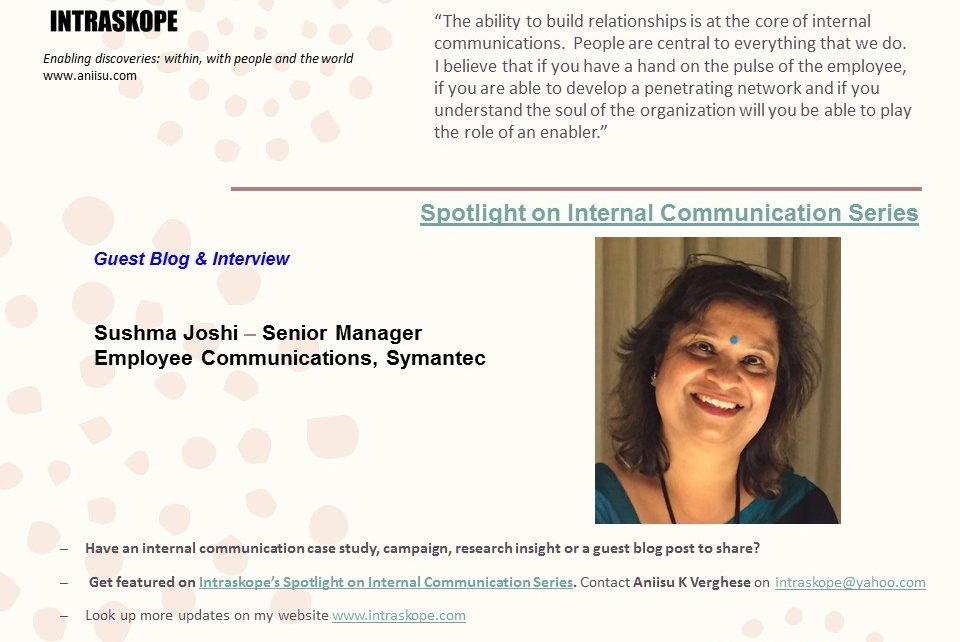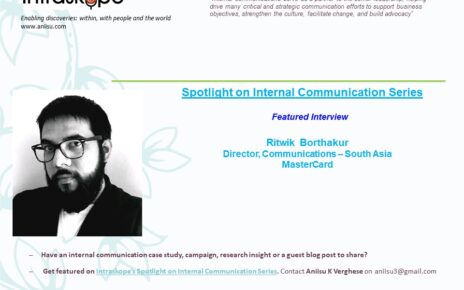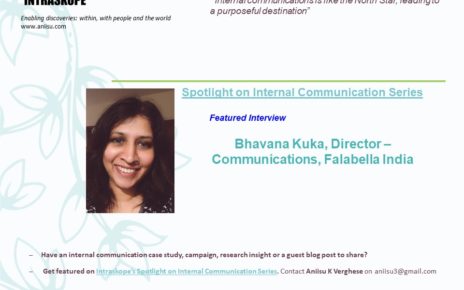Can internal communication get the respect it deserves? Is it possible for communicators to take a strategic view of the impact they do? How can the function rise above the continual asks for support to create a distinctive identity for the business?
These and other pertinent questions are covered in a thought-provoking blog post by this fortnight’s guest communication leaders Sushma Joshi, Senior Manager Employee Communications of Symantec. In the 18th edition of Intraskope’s Spotlight on Internal Communication Series, Sushma shares, in a guest blog, her opinion for communicators to think deeply about their role and how they add value to their organizations.
Sushma is an accomplished employee and change communication expert with demonstrated reputation of being a strategic partner across all levels of business. Skilled in internal communication strategy, comprehensive innovation related campaigns and change management frameworks she is a champion of diversity initiatives and leader of the women’s networking forum. Active in the professional community as an Advisory Council member of the Grace Hopper India Conference for women in Technology. She is also the Lead organizer of the ‘Pune.AnitaB’ network and the chairperson of the Prevention of Sexual Harassment Internal Committee in her organization.
In the interview that follows, she addresses the need for internal communicators to develop strong relationships, focus on building key skills, the importance of listening intently to stakeholders and networking.
Guest Blog
From Order Takers to Strategic Partners
“With great power comes great responsibility. This is my gift, my curse”,
said Peter Parker while reflecting on uncle Ben’s advice, in the movie Spiderman.
Most of us in employee communications face a similar predicament. We represent a function that has immense strategic potential but often gets stifled due to limited awareness, perception and understanding among the stakeholders. This is one unique function in an organization that is not bound by too many pre-conceived frameworks or set processes. Its strength lies in its abstractness, the malleability that it can demonstrate and a creative propensity through which it can cater to the organizational needs. A bonus – there is no monotony in this job. You can always experiment with varied, disruptive but impactful strategies.
The flip side (read real side) – it is viewed more as a support function, an order taker to business partners, in most of the organizations. A large part of our time and energy is expended in responding to requests rather than being a strategic, thinking pivot to which the stakeholders turn for counsel. Totally embroiled in tactical execution, how many of us create the time to think strategy? One of the primary drivers for this catch 22 situation is the near-universal task list that falls in our bucket. While this malady is the most common sore point among practitioners, yet the good news is that we now see an increased specialization of the function, in many organizations.
There cannot be a better time for us to thrive as a strategic function than in this second decade of the 21st century. The complexities of a dynamic business environment driven by acquisitions, mergers, technology that changes rapidly, the global nature of the workforce with multi-locational dispersed teams are all solid reasons for why companies need us. Employee communications is the enabler that plays a crucial role whether it is transformations, change management, building a corporate narrative or being the catalyst that inspires employees to connect the dots.
Thanks to the vantage point from where we operate – with access to business leaders, technical subject matter experts, employee forums and internal events – we can create a distinct identity for the function and create value for the organization. Want to get there? Then, begin at home. The first important step is to internalize the following:
- We are a strategic business function that is integral to the growth of the organization.
(Move away from the ‘support’ or ‘services’ mindset and strive to create a plan that incorporates strategy along with the tactical stuff).
- We are ‘Employee Communications’ and not ‘internal PR’ or the ‘design team’…we have an identity of our own and are driven by specific business goals.
(Create and reiterate this awareness among the stakeholders) - We are not ONLY email writers, website publishers or poster creators.
(Create a portfolio of success cases that will help others see beyond this)
Friends, rev up the accelerator to catapult from a ‘support function’ to a ‘business partner’. With my experience of more than a decade’s focus, here is what I wish to recommend to young communicators:
- Focus on developing business acumen. A solid grounding in the organization’s business is vital to building the strategic muscle.
- Work with a business plan in mind. This will help you align your work to business priorities as also assess and demonstrate impact.
- Make sure you engage with the key stakeholders to understand their business priorities. These are key insights that will help you create successful communication strategies.
- I always advocate varied communication interventions. While the usual town halls, intranet, newsletters or broadcast mailers are the trusted channels, yet there are immense opportunities to think creatively.
- Add and mix different channels, move away from corporate speak, customize narratives so that they are relatable to the new generation that is entering the workforce.
Employee communications finally seems to be turning the corner with expectations not being restricted to mere scripting, content development, collateral creation or intranet house-keeping. This is the opportunity to raise the bar!
Interview
- How did you get involved with internal communication?
I have delved into several aspects of communication before I realized that Internal Communications was my passion as well as my forte. Having started my career as a sub-editor in an English news daily, I moved on to freelancing and copy-writing in ad agencies in a couple of years when I took a break from full-time employment. After a few years off the radar, I chose to take small steps back into the work world by helping my friend’s communication consultancy start its operations in Pune. This stint proved to be a fertile breeding ground for developing contemporary skills in the field of communication along with a good grounding of the various aspects of business. Being a single person outfit, with support from an extended team in Mumbai, this start-up like experience gave me exposure to the whole gamut starting with how to position the services you offer; to customizing it to appeal to varied customer requirements; to execution of a project to customer’s satisfaction. It was hard work but worth every bit of it. From here I moved to an IT company where I was a part of the marketing team primarily working on developing content for a new product that the company was about to launch. This again involved everything from marketing collaterals, multi-media presentations, content related to the product on the company’s website to the content that gets printed on the packaging. After this I moved on to a corporate communication team where I got a good exposure to other areas of communication such as PR, corporate, financial communication and HR communication. This was where I got my first taste of internal/employee communication.
After a two-year stint I moved to Symantec. By this time, I realized that Employee Communications was where my passion and interests lied. The communication function in Symantec is much evolved with a distinct focus on PR, analyst relations and employee communications. I am with Symantec for a little over a decade now and have been responsible for setting up and building the employee communications function for our India centers.
- What do you think are the fundamentals of practicing internal communication?
I think the ability to build relationships is at the core of internal communications. People are central to everything that we do. I believe that if you have a hand on the pulse of the employee, if you are able to develop a penetrating network and if you understand the soul of the organization will you be able to play the role of an enabler. Relationships give you insights, they give you access, they help you establish credibility and they also earn you cooperation and support.
Besides this, I would recommend writing skills, articulation, a sound understanding of the business, a good design sense and an eye on the emerging media as the essential trappings of the communication tool-kit.
- Please share an example/campaign that you are personally proud of working on and that made a significant impact to your organization.
There have been quite a few campaigns that come to my mind.
When I started out at Symantec India about a decade back, we were a relatively new and upcoming center in India. There were lots of employee aspirations, the centers were christened as the ‘centers of innovation’ so the expectations on the technical front were high and we also had to establish our brand locally in order to attract good engineering talent. In this backdrop, the collective leadership at the site identified two business priorities for the organization.

- Build a strong and vibrant unified Symantec culture (so employees who came through acquired companies blend seamlessly into one synchronized identity)
- Build the technical/engineering muscle in the organization
In order to accomplish the above goals, the internal communication team played a very strategic role by implementing communication campaigns that were engaging, inclusive, participative and strategic (had our cultural ethos embedded within). Two of our high-impact signature campaigns that ran successfully for a more than a year were:
- MSMP (My Symantec My Pride): This was a sustained multiple year campaign that was designed to help employees experience the Symantec culture. This was a very impactful initiative, which the Internal Communication rolled out in partnership with the HR. We weaved and executed a variety of programs through this campaign. The success factors that contributed to the impact of the program were that it was not only a strategically conceptualized campaign that was executed with consistent cadence but was also collaborative in spirit as it included various internal stakeholders. The employees were the champions in most of the interventions, the programs were varied & consistently paced and the outreach was across board. Driven by a strong narrative, well-crafted messaging, creative packaging and across board engagement through the varied interventions, the impact was palpable.
- Tech Tracs: The objective of this initiative was to educate our employees on the exciting Technical Career opportunities available within Symantec. This initiative was also aimed at providing guidance to those who chose to pursue a career on the technical track. The impact of this successful campaign was that it helped us build an ecosystem that fostered a strong and vibrant technical community within the organization. This campaign succeeded to a large extent in getting visibility, recognition to the technical career growth path, helped cross-engineering team collaboration thus breaking silos, encouraged innovation and helped create technical role models.

4. If there was one aspect you can change about managing Internal Communication, what would that be?
I would want Internal Communication to be a strategic function that is involved in a project right from the inception stage and not as an afterthought. And, this change has to begin at home. As practitioners of the function we must start thinking strategy, and we must invest in building that awareness among the stakeholders.
5. What is your advice for people who are keen to join internal communications and make a career? What skills must they have or develop?
As mentioned in my blog above I think the spotlight today is on internal communications because of the dynamic ecosystem that organizations operate in. Employee communication and engagement is no more a ‘good to have’ but is a ‘must have’ for organizations. Informed employees are engaged employees and Internal Communications is the enabling function that plays a vital role in connecting the dots.
I think it is very essential for an internal communications professional to be:
- A relationships builder
- A creative & design thinker
- A good listener
- A well-networked individual
The essential took-kit (refer question 2) is already mentioned.
Missed previous stories from organizations featured on the Intraskope’s Spotlight on Internal Communication Series? Look them up here – Infosys, SOBHA Ltd., ICICI Securities, First Advantage, CK Birla Group, TVS Motors, GE, Suzlon, Tata Sons, Percept, Knight Frank, TCS Europe, Vedanta, Oxfam, Danske Bank, Diageo and Pandora.
Intraskope (www.aniisu.com) is the first blog on internal communications in India and among the earliest around the globe. Begun in 2006, the blog has over 530 posts on topics such as employee engagement, leadership communication and employee branding and receives thousands of visits from across the world. The blog, receives over 50,000 visits every month from over 50 countries globally, offers learning resources for practitioners, academicians, and students including industry workshops, research reports, and checklists. Intraskope has been featured on leading global internal communication forums like Simply-Communicate, IC Kollectif and International Association of Business Communicators. It is hosted by Aniisu K Verghese, author of Internal Communications – Insights, Practices & Models (Sage, 2012).
If you are an internal communication leader working in a firm or a not-for-profit anywhere in the world and have an internal communication case study, campaign, research insight or a guest blog post to share please contact me on intraskope@yahoo.com
You can also visit my website www.intraskope.com and You Tube channel to know more about my work



